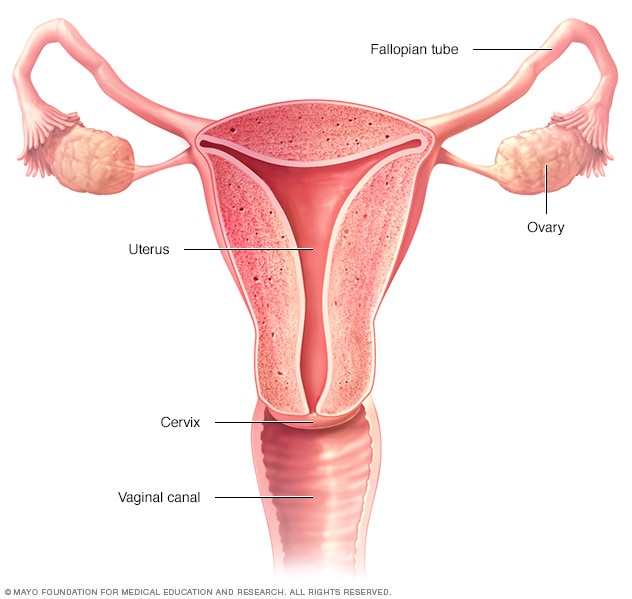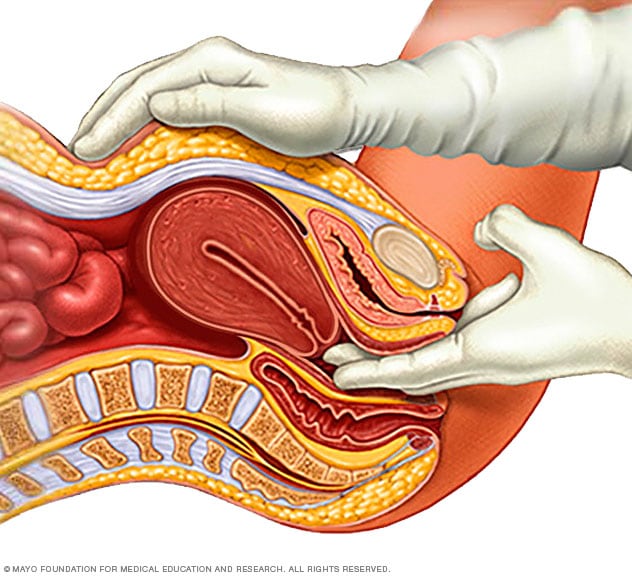Overview
Female reproductive system

Female reproductive system
The ovaries, fallopian tubes, uterus, cervix and vagina, also called the vaginal canal, make up the female reproductive system.
A pelvic exam checks the health of the reproductive organs. You might have a pelvic exam as part of your regular checkup. Not everyone needs the exam every year though. Some doctors recommend it only for certain reasons, such as having discharge from the vagina, pelvic pain or other symptoms.
A pelvic exam often lasts only a few minutes. Your doctor or other care provider checks your vulva, vagina, cervix, ovaries, uterus, rectum and pelvis for any unusual changes. A Pap test, which screens for cervical cancer, is often done during a pelvic exam.
Products & Services
Why it's done
You might need a pelvic exam:
-
To check your sexual and reproductive health. A pelvic exam can be part of a routine physical exam. It can find any signs of ovarian cysts, some sexually transmitted infections, growths of the uterus or early-stage cancer. The exam also is commonly done during pregnancy at the first prenatal care visit. Your doctor might recommend routine pelvic exams if you have a history of any conditions that affect the reproductive system.
There is a lot of debate among experts about how often to recommend pelvic exams, especially for people who aren't pregnant and don't have symptoms. Ask your care team what's right for you.
- To diagnose a medical condition. A pelvic exam can help find the cause of symptoms such as pelvic pain, unusual vaginal bleeding or discharge, skin changes, painful sex, or urinary problems. You might need more tests or treatment as well.
More Information
How you prepare
You don't need to do anything special to prepare for a pelvic exam. For your own comfort, you might want to schedule your pelvic exam on a day when you don't have your period. Also, you might be more comfortable if you empty your bladder before the exam.
Think about writing down any questions you have about the exam or its possible results. Take these with you to the appointment so you don't forget to ask them.
What you can expect
A pelvic exam is done in your doctor's office. It often takes only a few minutes.
You'll be asked to change out of your clothes and into a gown. You might be given a sheet to wrap around your waist for more privacy. Before doing the pelvic exam, your doctor might listen to your heart and lungs. Your stomach area, back and breasts also might be checked.
A third person called a chaperone might be in the exam room with you and your doctor. This person is often a nurse or a medical assistant. You can ask for a chaperone if you aren't given one. Or you could have a partner, friend or relative stay in the room with you.
During the pelvic exam
Pelvic exam

Pelvic exam
During a pelvic exam, a doctor inserts one or two gloved fingers inside the vagina. Pressing down on the abdomen at the same time, the doctor can check the uterus, ovaries and other organs.
Pap test

Pap test
During a Pap test, a tool called a speculum holds the vaginal walls apart. A sample of cells from the cervix is collected using a soft brush and a flat scraping device called a spatula (1 and 2). The cells are placed in a bottle that contains a solution to preserve them (3). Later, the cells are checked under a microscope.
You'll lie on your back on an exam table with your knees bent. Your feet will usually be placed on the corners of the table or in supports called stirrups. You'll likely be asked to slide your body toward the end of the table and let your knees fall open.
A pelvic exam most often includes:
- External visual exam. First, your doctor will likely look at your vulva to check for unusual signs. These can include irritation, changes in skin color, sores and swelling.
-
Internal visual exam. Next, your doctor will likely use a plastic or metal-hinged tool called a speculum to spread open the walls of the vagina. This allows your doctor to see the vagina and cervix. The speculum is shaped like a duck's bill. It might be warmed before it's inserted to make it more comfortable for you.
The speculum can cause pressure that might feel uncomfortable. Try to relax as much as possible to ease discomfort. But speak up right away if you have pain. Your doctor can stop the exam and talk with you about any concerns you have.
- Pap test. Your pelvic exam might include this test, which also is called a Pap smear. A small wand is used to collect a sample of cells from your cervix before the speculum is removed.
-
Physical exam. The pelvic organs, including the uterus and ovaries, can't be seen from outside the body. Your doctor needs to feel your stomach area and pelvis for this part of the exam. The doctor inserts one or two lubricated, gloved fingers into your vagina with one hand. At the same time, the other hand presses gently on the outside of your lower belly.
During this part of the exam, the size and shape of the uterus and ovaries are checked. Any tender areas or unusual growths are noted. After the vaginal exam, your doctor might insert a gloved finger into your rectum. This is done to check for tenderness, growths or other unusual signs.
At each step of the pelvic exam, your doctor tells you exactly what's being done. That way, nothing comes as a surprise to you.
After the pelvic exam
After the pelvic exam is over, you can get dressed. Then your doctor will talk with you about the results of your exam.
Results
Your doctor often can tell you right away if the pelvic exam found anything unusual. Pap test results might take a few days. You'll likely talk about any next steps, other tests, appointments or treatment that you need.
Your pelvic exam is a good time to talk about your sexual or reproductive health. If you have questions, be sure to ask them during your visit.